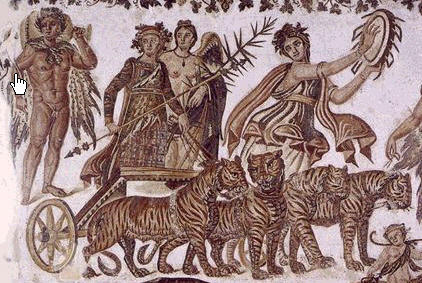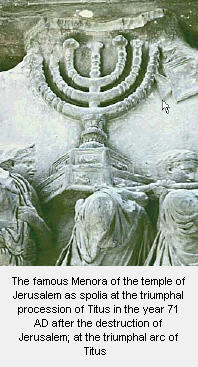
| AUTORBIS.net | created 2003 - 2005 |

| The name "Trionfi" was born out of a ritual call used at festivities "io triumpe" at the epiphany of a god,
probably often enough especially for the god Bacchus, whose myth describes series of triumphal processions from India till Greek.
His chariot mostly is drawn by tigers and this special feature beside some other attributes might suspected to have developed after the victories of
Alexander the Great in 4th century BC. It is a common esperience, that the use of alcohol (Bacchus is the god of wine) inspirates people to become a little louder with their voice than usual. "Io triumpe!", it's imaginable, that the call had a rather similar basic scenario as calls like "Kölle Alaaf" accompanying modern humoristic triumphal processions in carnival (in this case Cologne carnival). Probably the Greek term "Uriambos" went from Minor Asia through Etrurian modifications to the Romans, where it was as "Triumph" established as name for political important triumphal processions after great victories. These triumphal processions probably were influenced by an already existing annual festivity at the begin of a new year, in which the porta triumphalis in Rome had a fixed and important function. At the full developed Roman triumphal procession the triumphator was suited with a toga purpurea (in red, decorated with palm-branches), the laurel crowned his head, he had a scepter made from ibony with two eagle-heads and the face was coloured red with mennige as the statue of Iuppiter Optimus Maximus (the temple of Iup. Opt. Max. in Rome was the final end of the triumphal procession). The triumphal chariot was drawn by 4 horses, since Caesar white horses were prefered. The right to a triumphal procession belonged only to the Imperator in the later time, the last exception of this rule was Titus in the year 71 AD. A triumphal procession was allowed in the case of a victory with more then 5000 dead enemies, and it was not allowed in cases of civil war (exceptions of this rule in later time, Constantin in 312 AD, Constantin II. in 357, Theodosius 389). The allowance was debated in the senate, often with much opposition in the earlier time; Lucullus for instance had to wait 3 long years, and the Imperator was not allowed to enter the city in that time. Occasionally the allowance was negated and replaced by a minor important ovatio or Triumphus in monte albano at the costs of the Imperator himself (at an ovatio the victor marched by his own feet or on horse, not in a chariot, he was crowned with myrte, not with laurel, the music was done with flutes and not with trumpets, the final aim was the Capitol, not the Iuppiter Opt. Max. temple). Connected with the triumphal procession was a voti soluti, an action of purification, also the sign, that the soldiers had done the ordered job. The route of the triumphal procession started at the Campus Martium outside of the city, it entered the city at the Porta Triumphalis, which was only opened at such occasions. It moved counterclockwise through the city, finally ending at the Jupiter-temple. The course could have been altered according to the personality of the Imperator, but had some fix points: Circus Flaminius, Velabrum, Via Sacra-Forum, probably also Circum Maximum, Forum Boarium. In the triumphal procession were: 1. a presentation of the victory and the spolia (spoil) 2. the group of the triumphator with laurel ranked prisoners of war, accompanied by lictors to guard them 3. Soldiers singing songs of praise or mockery Interesting is the participance of a slave at the chariot of the triumphator, who had to whisper during the procession into the ears of the imperator: "respice post te, hominem te esse memento", reminding him, that he's only a human and not a god. Also it is remarkable, that it is assumed, that already the triumphal processions were accompanied by allegoric figures, cause some of the survived 364 (! according "Der Kleine Pauly", 1979 ) Roman triumphal arcs showed allegoric symbols of victory or peace just like it became custom during the medieval Trionfi. The article of Peter J. Holliday: The Origins Roman Historical Commemoration in the Visual Arts gives some more informations to the triumphal processions of the Romans. |
 |